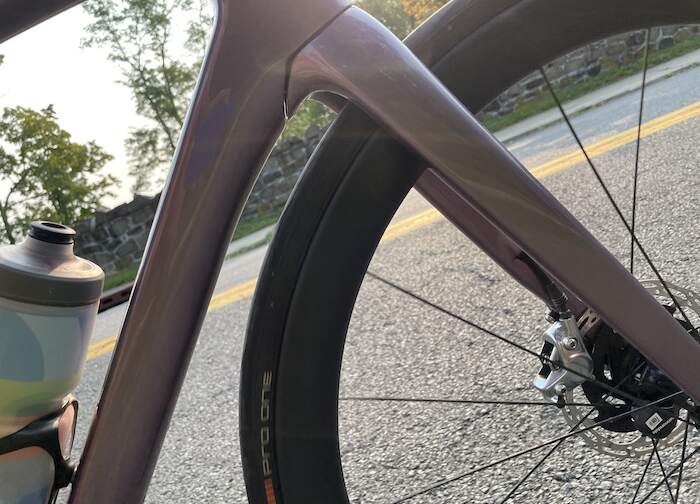
This post is about the Cannondale Super Six EVO Hi-Mod SRAM Red.
Or: why you should spend an outrageous amount of money to get the bike you lust after.
Hi, my name is David, and I have a bike problem.
Over the last thirty years of being a cyclist, I have owned more “perfect” bikes than I can count. When I was growing up, my father, a commercial photographer, had a sign in his office that said, “the bitterness of poor quality is remembered long after the sweetness of low price is forgotten.” This sign, which I think was from Snap-On tools, was a quote from founding father, and notable skinflint Ben Franklin. It was echoed by my grandfather, who grew up during the depression, and said to me, “if you’re going to spend your money on something, buy the best thing you can, and you’ll never have to buy it again.”
My first perfect bike was a heavy, steel 1970’s women’s=step-through Raleigh three-speed with Sturmey Archer hubs. It was perfect because it was the bike that I was given by a friend, which turned me into a cyclist. I’ve also owned a perfect Spooky Mothership; a perfect Litespeed Classic modified with S+S couplings to become a travel bike. I’ve also had an ideal Calfee Dragonfly and an ideal Cannondale Super Six EVO from the previous generation of Super Six.
That last bike tipped the scales at just over 13 pounds when built up with a selection of lightweight parts. Climbing a hill on a 13-pound bike is impressive, but descending was always a bit sketchy with the rim brakes and thin tubes. I’d ride my brakes the whole way down a hill. The Calfee was also light as a feather and scared the crap out of me on downhills with rutted shoulders.
My justification was that I spent all my free time on my bike, and I should enjoy it as much as possible. I never regretted my choices.
Weight Weenie
While I like the idea of disc brakes, wide tires, and aero tube sets, the weight of today’s road bikes just seemed so out of line with the featherweight bikes I loved so much.
This year, with used bike prices soaring thanks to COVID, I sold my older Super Six and plunked money down on the 2020 model Cannondale Super Six EVO with SRAM Force. What I actually wanted, though, was the Super Six EVO Hi-Mod with Red, but with a price above $10,000, it was too ridiculous.
It was a great bike, but I immediately regretted the purchase. The bike felt great, shifted perfectly, and looked hot as hell. But coming from a 13-pound bicycle, the 18-pound weight of the Super Six EVO drove me insane. I’d spend every ride thinking about the bike that I had really wanted, and picture all the components I’d swap out to make it lighter over time.
My local shop, Piermont Bicycle Connection, has a great eBay program—bring anything in, and they’ll eBay it for store credit. I had a ton of old camping, photography, and electronics gear, and I got them all in, as well as a few bikes I no longer was riding. Before I knew it, I was a few grand short of the Super Six EVO Hi-Mod price. I had them sell my Super Six EVO, and I walked out the door with the Super Six EVO Hi-Mod.
And now I have another perfect bike to add to the list. This EVO is super-light for a modern road bike and entirely built up, even with Look Keo pedals, it’s only 16.05 pounds.
Specs In A Nutshell
By almost any sane measure, the Cannondale Super Six EVO Hi-Mod is an absurdly expensive bike. With a list price of $12,800, the bike is out of the reach of the majority of cyclists. If it weren’t for the value of my previous Cannondale on eBay and a box of collectibles I found, it would be well out of my reach as well.
With a slightly sparkly lavender paint job and a near-complete lack of logos, the bike doesn’t turn heads the way the white-and-black SRAM Force version did, and that’s fine with me. I’ve never liked to telegraph the value of my bikes, and I have even plastered stickers all over my travel Litespeed, so it looks like a beater bike.
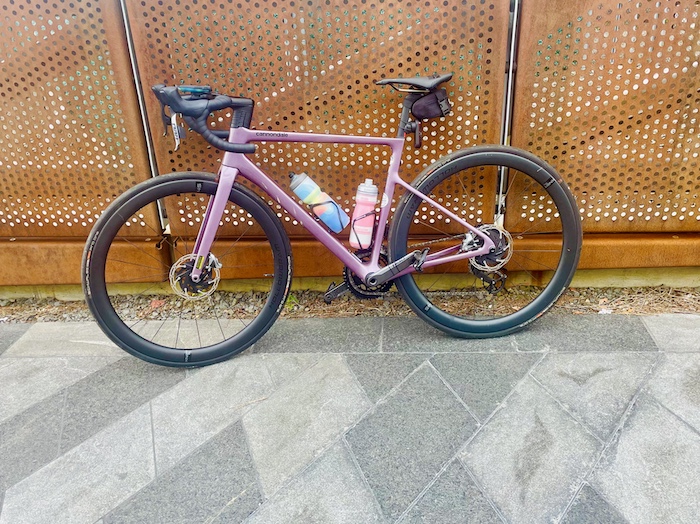
There are two Super Six EVO Hi-Mod iterations, one with SRAM Red and one with Shimano Dura-Ace Di2. The Shimano version is a team replica with pink and blue and a Rapha logo, so the opposite aesthetic to the Red version. Generally, I like Shimano’s shift lever functionality slightly more than SRAM’s, but I love them both, and with the Red version, I get 12 cogs instead of 11. (At the time of writing this, the new Di2 has been announced but is not yet in the lineup. With the global part shortage, it’s unlikely to come to bikes until 2022 at the earliest.)
The 12-speed cassette can work with the new SRAM Red long cage derailleur to go to a max of a 36T cog over the standard 34T on the regular Red setup. Since the long cage wasn’t available and I wanted a bit more range for the large hills surrounding my house, so I opted for a third-party ceramic-bearing pulley system, which has worked remarkably well.
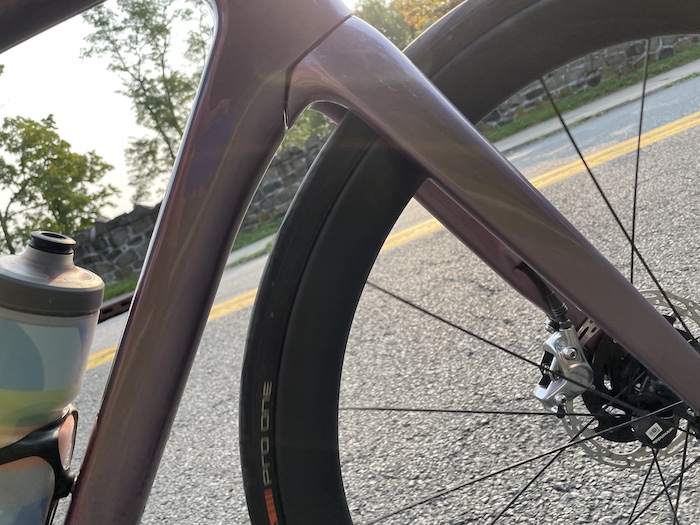
The EVO is equipped with HollowGram 45 SL KNØT carbon wheels and the integrated SAVE SystemBar. I have an issue with flat top bars that are too deep as they tend to press on my wrists, but the amount of variability in hand position on the bars has left me wrist-pain-free so far.
At some point, I’ll place SRAM blips remotes shifters on the bottom of the bars near where the handlebar tape ends; as I spend so much time on the flats on a ride, it would be great to shift without having to move to the shift levers.
Turning to wheels, the hubs on the HollowGram 45 SL KNØT wheels are much quieter than those on the standard EVO model, and they’re quick to accelerate and haven’t been problematic during crosswinds, and rode the bike in a downpour with gusts and didn’t feel the deep rims acting like a sail.
The wheels are tubeless-ready, so I immediately swapped to a Schwalbe tubeless set, which provides a much more comfortable ride than the stock tires and tubes. As with all tubeless setups, the lack of an inner tube allows for various pressures, allowing a rider to customize their ride.
The stock saddle is a listed as a Fizik Tempo Argo R3 with K:ium rails, though mine came with a Prologo super-light snub nose saddle, which is definitely a good choice for racers picking up this bike, but snub-nose saddles don’t give me a lot of position choices on a century.
After a few hundred miles on the saddle, I ended up switching it out with a Fizik Antares Versus EVO R1 saddle (another ridiculously high-priced item—a review is coming soon), a super-light 3D printed saddle (yes, you read that right) that is super comfortable and has a traditional longer nose than the stock saddle. On long rides, the lack of positions with a snub nose saddle bothers me, and I prefer to have a bit of a saddle nose to move around to give some relief to my sit bones. That said, the stock saddle is incredibly comfortable and a perfect choice if you’re racing.
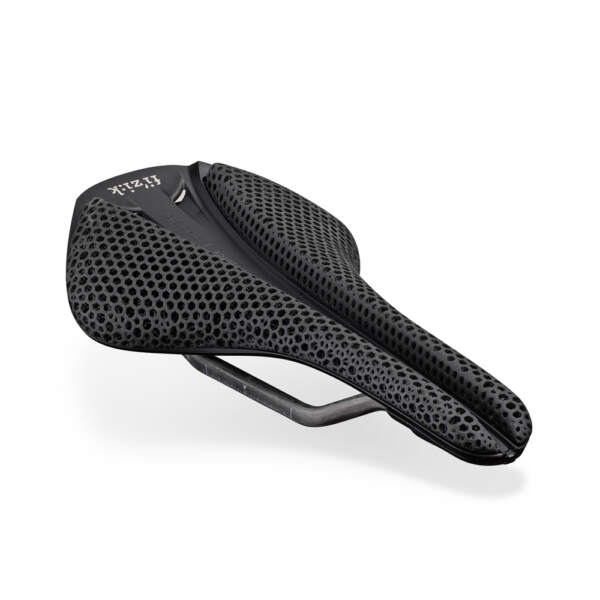
With its distinctive shape, the HollowGram seatpost is in no danger of rotating, but if you plan to adjust the height, invest in a torque wrench and some carbon paste first. The bolt force is 6nm, and it’s very easy to overtighten the bolt and damage the post and/or the frame.
One of my favorite touches is the lack of visible cables. The EVO uses oversized spacers to create a channel to route cables. There are only two brake cables with SRAM’s wireless shifters to route, and they pass into the frame without being visible.
Since big tires are the new skinny tires, the EVO models are designed to take up to a 30mm tire, though many people online have said they can run up to 34mm without problems. This clearance makes for a wide range of tire choices and is one of the reasons I went with Schwalbe tubeless tires.
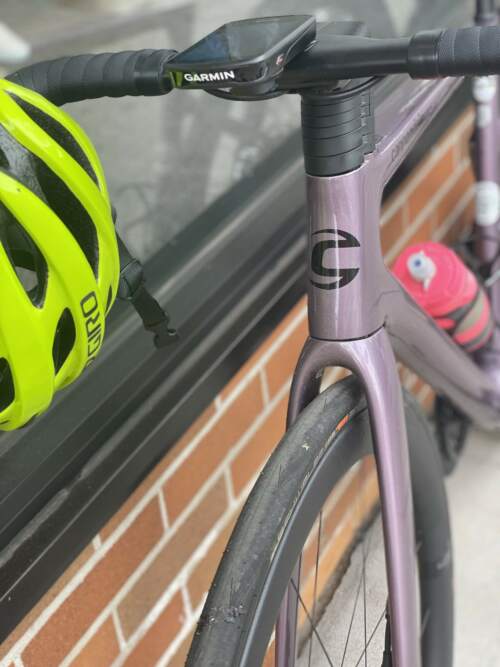
Watts Happening!!
Cannondale claims the aero frameset results in 30 watts saved over my previous Cannondale EVO Super-Six shape. These savings are at 30 mph, a speed I’m unlikely to maintain on the flats anyhow, but the bike does feel noticeably more efficient than my previous EVO at my normal speeds of 20-ish on the flats. On a local rail-to-trail that I regularly ride, I set several Strava personal records for the segments I usually do.
Climbing, the bike is noticeably stiffer than the last-gen EVO and much stiffer than the Calfee I had before that. Even with the custom tubing of the Calfee, my always-heavier-than-I’d-like body generates a lot of torque.
As a person in his early fifties, I’m not as spry as when I was in my 20’s, so I can use every watt I can get. My age is another reason I got this bike: at some point, I’ll be one of those 70-year-old guys riding very slowly, and I figure that I should get the most out of my riding while I can.
I took several years off of cycling due to a foot injury, so my climbing isn’t what it used to be, and the relatively low weight of the EVO Hi-MOD makes up for it (though I do miss my 13lb bike on longer climbs). The bike is so efficient that I’ve only once used the 36T cog, and I am considering going back to the 34T just to have smaller spacing between the two largest cogs.
While my climbing isn’t up to what it was in years gone by, I’m still able to kick out fast speeds on the flats (a good amount of that is the aero tubing and stiffness) and climb so effectively that I have only once used the larger 36T ring, to grind out a multi-mile climb.
Full Stop
When descending, my fear of speed has disappeared. Disc brakes provide such an improved stopping power that I’m confident I can come to a stop in an emergency, and the big tires soak up much of the road chatter and bumps that are so common on the roads around my house.
On a recent ride with friends I hit about 45 mph tucking myself down low on the hoods and getting as aero as my body will allow. My previous descending speed records were closer to 20, as I’d ride the brakes on the pothole-strewn roads near my house, always fearing I wouldn’t be able to stop or swerve around an obstacle. The bigger tires help here too as a bike with 32mm tires is a lot more pothole-forgiving than one with 20mm tires.
I did have to have the brakes bled as their contact point was incredibly close to the bars. During a panic stop, my shift levers were only away from the bars by a few millimeters. This isn’t a problem with the bike or the shifters, but more of a reminder to always check your brakes when buying a new bike.
Ride Experience
The best bike is one that you hardly notice—it should be stiff when you need to sprint, it should be compliant enough to make a long ride comfortable, shifting should happen without hesitation, steering should be responsive, and braking needs to be both powerful and flexible.
The Cannondale Super Six EVO Hi-MOD is all of these things. Whether I’m doing a short, fast ride or a century, the bike disappears under me. Even my beloved last-generation EVO didn’t seem as invisible. The closest I’ve come to a bike this superb was my custom Calfee, though the bottom bracket wasn’t nearly as stiff as today’s oversized BBs.
Swapping to tubeless tires is a must, though, as the lower possible tire pressures make for a much more comfortable ride, and the aforementioned pothole-eating.
Power Metering and Tech
Since the EVO is equipped with SRAM AXS components, it’s compatible with SRAM’s Quarq bolt-on crank power meter. Easy to install, easy to use, the Quarq power meter is unfortunately also nearly as heavy as the whole bike frame, though relatively affordable. At about 1.4 pounds, it’s a lot of weight to strap onto a super-light bike, primarily as it only really measures one side and estimates the second side. At about $500, it’s still within the range of the aspiring crit racer or multi-day competitor, and it’s cheap enough that the weekend warrior (especially a weekend warrior that just dropped more than $10000 on a bike) can certainly afford it.
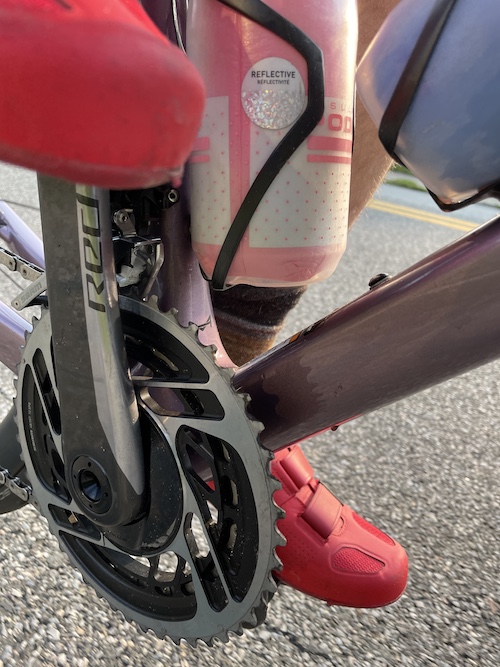
Another option for power-meter fans is Garmin’s Rally power meter pedals. While the entry-level set is much more expensive than the crank-based option, the RK100 comes in at around $650, and the high-end RK200 pedals at $1099. The RK200 pedals are a claimed 326 grams, which makes them half the weight of the Quarq, and since you need pedals anyhow, they’re only about 145 grams heavier than the lightest Look pedals you can install, the Carbon Blade Ceramic.
The Rally pedals also provide detailed information on pedal dynamics and cadence, showing correct cleat placement, standing vs. sitting power, and much more.
In other words, if you want power metering on this bike (or any bike), skip the SRAM solution and go with the Garmin pedals.
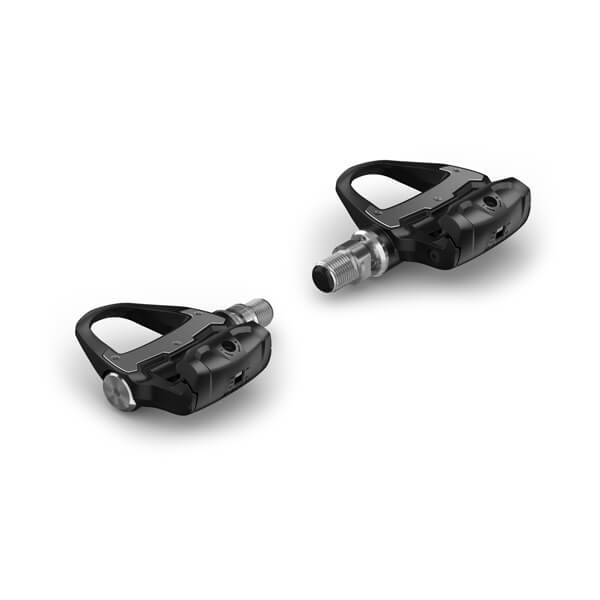
The EVO also has a built-in speed sensor on the front wheel, which communicates with any bike computer. It’s a good option for those times when GOS drops, and you still want to see your speed. As of this writing, there’s a bug with the Hammerhead Karoo 2, where having this sensor active occasionally results in a reading of zero MPH. Still, we’ve reported that to the developers.
I’m not sure why the speed sensor is on the front wheel–had it been mounted to the back wheel, it would be much easier to track indoor trainer rides, but it’s also not difficult to get a third-party wheel sensor and mount it on the rear wheel.
Connectivity
The EVO models talk directly to a Cannondale app, though it’s essentially just to track rides. Anyone using a bike computer with a Strava or other training account has better metrics from those tools. Still, it’s nice to have a computer built into the phone, as many people use their phones as their primary computer these days.
SRAM AXS bikes also talk to the SRAM app, which allows for tweaking of the shifter functionality. I like to have my right shifter moving to an easier gear instead of a harder one, as I don’t race, so I’m more likely to want to dump gears to climb a hill than rapidly shift for a sprint. The app also allows you to set the cassette to compensate when shifting the big ring by performing a single or double cassette shit when changing the rings, preventing the awful spin-wobble that comes as you go from the big ring to the small ring and find yourself spinning without providing much torque.
Speaking of connectivity, the Cannondale comes with an integrated Garmin mount built in, which puts the computer in the right position ahead of the bars without needing to clamp anything to the bike.
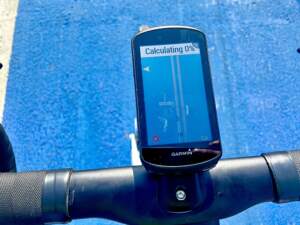
I’ve mounted the Garmin 830, the Garmin 1030 Plus (which I reviewed) and the Hammerhead Karoo 2, and they all fit solidly, and lack any shake or instability, and again, no need to try to mount a computer to flared handlebars.
Conclusion
The Cannondale Super Six EVO Hi-MOD is too expensive a bike for the majority of riders. It falls quickly into the category of “bike porn,” and there’s a substantial diminishing return between the non-Hi-Mod model and the Hi-Mod. No bicycle should cost as much as a used car, but this is a dream bike for the right customer.
I had to sell off years of bike gear (including my gravel bike—not sure what I’ll do this fall), many collectibles, and lots of electronics to get this bike. Younger me would have been fine riding the non-Hi-MOD version, but after years of being off the bike due to an injury, the Cannondale Super Six EVO Hi-MOD is an absolute treat, and it’s reignited my passion for riding long and riding fast.
If you’re a racer looking for the ultimate competitive edge that still is within the UCI weight limits, this bike is worth every penny. If you’re a hardcore weight-weenie willing to spend top dollar for the best trade-off between performance and weight, this bike is for you.
For anyone else, the Hi-MOD is likely overkill, and you’d be better off getting the standard EVO with a less expensive parts group. Even Rival AXS these days shifts as well as Red does, and Shimano Ultegra is as accurate and fast as Dura-Ace.
Without a doubt, though, this bike will be the standard against which other bikes are judged. The bike’s lightweight and its trade-off between stiffness and compliance, so it won’t beat you up on a century, and it’ll make you feel like Cavendish on a town-line sprint. I foresee many bike review articles including phrases like “while not as light as Cannondale’s Super Six EVO Hi-MOD…”
If you’re a customer of this bike, you already know who you are, and you should get this bike, as it will be one of the best investments in cycling you could make. It’s out of the range of most riders, and for a good reason. This bike is designed to be as much a showpiece for Cannondale (and for owners of the bike) as it is to be a performer.
Years from now, the pendulum of bike design may swing again, heading back to lighter and more traditional tubes, but while aero and disc brakes are the standard, the Cannondale Super Six EVO Hi-MOD may well be the best bike ever built.
…We're riding townies, adventure, and mountain bikes. Find recommendations on our store page. As Amazon Associates we earn from qualifying purchases.